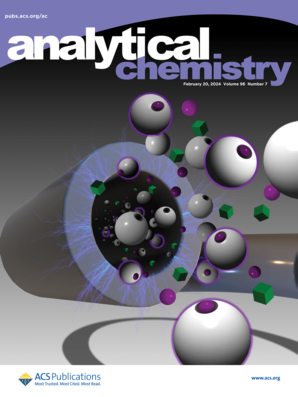Skylite:基于skyline的脂质异构体保留时间评估在代谢功能障碍相关脂肪性肝炎中的脂质组学研究
IF 6.7
1区 化学
Q1 CHEMISTRY, ANALYTICAL
引用次数: 0
摘要
代谢功能障碍相关的脂肪性肝病(MASLD)是世界范围内最常见的肝脏疾病,可发展为脂肪性肝炎。新发脂肪生成(DNL)升高是肝脏脂肪变性的关键因素。脂肪酸(FA)去饱和产生几种结构非常相似但具有不同生物学功能的不饱和脂质异构体。然而,由于它们的结构相似性,许多传统的质谱方法无法检测到这种代谢变化。因此,我们引入Skylite (Skyline-based脂质异构体保留时间评估)工作流程,使用传统的液相色谱-质谱(LC-MS)来识别重要的异构体特征。将同分异构体磷脂酰胆碱的保留时间与表征良好的人血浆参考标准NIST 1950进行了比较。保留时间趋势与液相色谱和臭氧诱导解离质谱数据中固定电荷衍生化FA有很好的相关性。这一解释得到了双键诊断片段在LC-MS /MS实验环氧化水解脂肪酸的支持。我们研究了肝脏脂质谱,重点研究了代谢功能障碍相关脂肪性肝炎(MASH)的两种小鼠模型中的酯化脂肪酸。在37个磷脂酰胆碱组合物中,该工作流程确定了123个脂质特征。重要的是,ccl4诱导和黑素皮质素-4受体敲除小鼠在西方饮食(WD)中具有显著更高水平的蜂蜜酸,支链脂肪酸和n-7 PUFA纳入磷脂酰胆碱。虽然MASH小鼠肝组织中含有大量的n-7 PUFA,但未检测到n-10 PUFA,这可能表明一种独特的去饱和模式。筛选改变的脂质异构体谱弥合了高通量分析和专门的结构分辨技术之间的差距。本文章由计算机程序翻译,如有差异,请以英文原文为准。

Skylite: Skyline-Based Lipid Isomer Retention Time Evaluation for Lipidomics in Metabolic Dysfunction-Associated Steatohepatitis
Metabolic dysfunction-associated steatotic liver disease (MASLD) is the most prevalent liver disorder worldwide and can progress to steatohepatitis. Elevated de novo lipogenesis (DNL) is a key contributor to hepatic steatosis. Fatty acid (FA) desaturation produces several unsaturated lipid isomers that are structurally very similar but have diverse biological functions. However, due to their structural similarity, many conventional mass spectrometry approaches cannot detect such metabolic alterations. Thus, we introduce the Skylite (Skyline-based lipid isomer retention time evaluation) workflow using conventional liquid chromatography–mass spectrometry (LC–MS) to identify important isomer features. Retention times of isomeric phosphatidylcholines are compared with the well-characterized human plasma reference standard NIST 1950. Retention time trends correlate well with fixed-charge derivatized FA in liquid chromatography and ozone-induced dissociation mass spectrometry data. The interpretation is supported by double bond diagnostic fragments in LC–MS/MS experiments of epoxidized hydrolyzed fatty acids. We investigate hepatic lipid profiles, focusing on esterified fatty acids in two mouse models of metabolic dysfunction-associated steatohepatitis (MASH). Out of 37 phosphatidylcholine sum compositions, the workflow identifies 123 lipid features. Importantly, CCl4-induced and melanocortin-4 receptor knockout mice on a western diet (WD) have significantly higher levels of mead acid, branched-chain fatty acid, and n-7 PUFA incorporated into phosphatidylcholines. While the MASH mouse liver tissues contain notable amounts of n-7 PUFA, no n-10 PUFA were detected, potentially indicating a unique desaturation pattern. The screening for altered lipid isomer profiles bridges the gap between high-throughput analyses and specialized structure-resolved techniques.
求助全文
通过发布文献求助,成功后即可免费获取论文全文。
去求助
来源期刊

Analytical Chemistry
化学-分析化学
CiteScore
12.10
自引率
12.20%
发文量
1949
审稿时长
1.4 months
期刊介绍:
Analytical Chemistry, a peer-reviewed research journal, focuses on disseminating new and original knowledge across all branches of analytical chemistry. Fundamental articles may explore general principles of chemical measurement science and need not directly address existing or potential analytical methodology. They can be entirely theoretical or report experimental results. Contributions may cover various phases of analytical operations, including sampling, bioanalysis, electrochemistry, mass spectrometry, microscale and nanoscale systems, environmental analysis, separations, spectroscopy, chemical reactions and selectivity, instrumentation, imaging, surface analysis, and data processing. Papers discussing known analytical methods should present a significant, original application of the method, a notable improvement, or results on an important analyte.
 求助内容:
求助内容: 应助结果提醒方式:
应助结果提醒方式:


